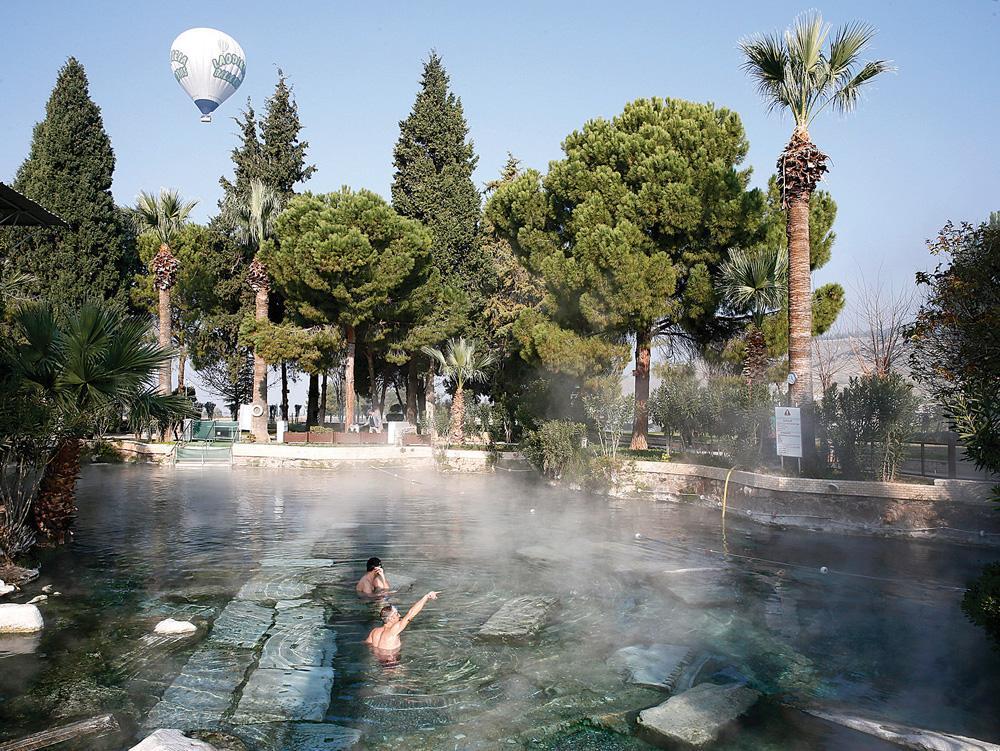'Nature havens' in Turkey's west attract hot spring visitors
BOLU – DENİZLİ

Turkey’s “white paradise” Pamukkale, a UNESCO World Heritage site, offers unique wellness treatment opportunities thanks to its antique hot springs and mineral-rich thermal pools.
Located in the southwestern province of Denizli, Pamukkale (cotton castle) stands over the ruins of the ancient city of Hierapolis.
It has been a spa town and thermal treatment center for millennia since Roman times. It is especially famous for its white limestone travertines, shaped by calcium-rich hot springs.
A natural spring, situated at close proximity to the white terraces of travertine, Pamukkale is particularly popular with tourists. Dating from ancient Hierapolis, this pool was formed naturally after the collapse of a series of columns in an earthquake in 692 A.D., which had caused thermal water to accumulate.
With its water temperature fixed at 36 degrees Celsius regardless of the season, the pool offers its visitors a unique experience. It is believed to have healing benefits for cardiovascular diseases, rheumatism, skin and nerve diseases, as well as intestinal disorders.
Gazi Murat Şen, the president of a Denizli-based local tourism and hotel management association, told Anadolu Agency that Pamukkale, which he noted was one of the most visited tourist attractions of the country, had recently regained its reputation as a center of health tourism.
“All facilities and hotels were quickly sold out for the upcoming semester,” Şen said.
He drew attention to the Karahayıt region of the province, saying it could soon be declared “a city of thermal cure.”
“If this happens, we think it will boost the tourism investments in our city,” said Şen.
The unusual red water of the Karahayıt thermal pool, which remains at an average of 60 degrees Celsius throughout the year, is rich in iron. This red water is believed to help those with rheumatism, asthma, bronchitis and skin diseases.
The Black Sea province of Bolu, a big tourist attraction with its Lake Abant, Yedigöller (Seven Lakes) and Gölcük Nature Park, is also a leading thermal and health tourist magnet, according to the city’s governor.
Also, Bolu has more to offer in thermal and health attractions. There are 30 thermal springs in the Seben, Göynük, Mudurnu, Karacasu and Taşkesti districts. The heat of the spring water ranges from 20 to 90 degrees centigrade.
In the Karacasu district, thermal spring water is used for both healing hospital patients and hotel tourists.
Also, in the Mudurnu, Taşkesti and Göynük districts, which are ancient Ottoman towns and located on the Silk Road, recently built thermal facility and time-share properties contribute to Bolu’s thermal tourism. The ancient Ottoman bathhouses in Mudurnu and Göynük districts also attract tourists.
The Silk Road or Silk Route is an ancient trade network through regions of Eurasia connecting the East and West, stretching from the Korean Peninsula and Japan to the Mediterranean Sea.
In the Kesenözü village in Seben, Pavlu Hot Springs offer healing to those who suffer from various diseases, such as rheumatism, gynecological diseases and dermatological disorders. The hot water’s heat ranges between 60 and 90 degrees centigrade.
In 2016, facilities in Karacasu, Seben and Mudurnu hosted a total of 138,685 visitors, including 7,165 foreigners.
The city is rich in many areas including tourism, Bolu Governor Aydın Baruş said.
“We have natural beauty sites in our province that are famous in the country and international scale. In only [Lake] Abant, Yedigöller and Gölcük, we have more than a million visitors a day,” he added.
Baruş also stated that they are trying to make the sites available for accommodation, increasing bed capacity.
“Bolu has important thermal springs. It has shown good progress in [building] facilities. There are currently two thermal springs operating and a total of 878 beds in these facilities. On the other hand, there are around 4,500 beds in three time share property facilities,” he said, adding that they aim for 20,000 beds in a few years.
















